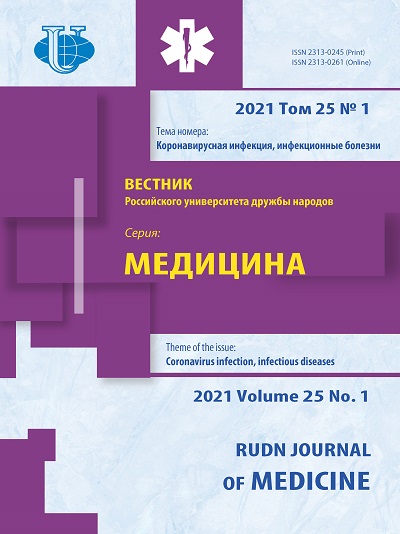Оценка роли полиморфных вариантов генов IL6 и IL10 как фактора риска развития рестеноза у пациентов после имплантации стентов с лекарственным покрытием
- Авторы: Тимижева К.Б.1, Агаджанян А.В.1, Цховребова Л.В.1,2, Шугушев З.Х.1,3, Азова М.М.1
-
Учреждения:
- Российский университет дружбы народов
- Федеральный научно-клинический центр физико-химической медицины
- Центральная клиническая больница № 2 им. Н.А. Семашко ОАО «РЖД»
- Выпуск: Том 25, № 1 (2021): КОРОНАВИРУСНАЯ ИНФЕКЦИЯ, ИНФЕКЦИОННЫЕ БОЛЕЗНИ
- Страницы: 48-54
- Раздел: ЭКСПЕРИМЕНТАЛЬНАЯ И КЛИНИЧЕСКАЯ ФИЗИОЛОГИЯ
- URL: https://journals.rudn.ru/medicine/article/view/25437
- DOI: https://doi.org/10.22363/2313-0245-2021-25-1-48-54
- ID: 25437
Цитировать
Полный текст
Аннотация
Актуальность . В настоящее время наблюдается увеличение количества чрескожных коронарных вмешательств, что приводит к росту абсолютного числа случаев рестеноза, основного осложнения, развивающегося в отдаленном послеоперационном периоде. Поиск факторов риска рестенозирования стентов и определение механизмов развития повторного сужения артерий с целью профилактики данного осложнения является актуальной задачей в интервенционной кардиологии. К факторам риска развития рестеноза относят клинические, ангиографические и генетические факторы. В настоящее время проводится активный поиск биомолекулярных маркеров, ассоциированных с развитием рестеноза коронарных артерий. Цель : исследование роли полиморфных вариантов C-174G гена IL6 и C-819T гена IL10 как фактора риска развития рестеноза у пациентов после стентирования коронарных артерий. Материалы и методы: в исследовании принимали участие 113 пациентов со стабильной формой ишемической болезни сердца, которым ранее проводились баллонная ангиопластика и имплантация стентов с лекарственным покрытием и 62 пациента с интактными артериями, включенных в контрольную группу. Статистическая обработка данных проводилась с помощью программы R-language и пакета программного обеспечения SPSS Statistics 20. Результаты . Были выявлены статистически достоверные отличия по полиморфизму гена IL6 между пациентами с ИБС и контрольной группой. Обнаружена ассоциация генотипа GG по гену IL6 с развитием ИБС. В подгруппе пациентов старше 65 лет и рестенозом генотип GG встречается достоверно реже. Гомозиготный генотип СС по гену IL10 ассоциирован с ранним развитием рестеноза внутри стентов.
Ключевые слова
Об авторах
К. Б. Тимижева
Российский университет дружбы народов
Автор, ответственный за переписку.
Email: kalima.bogatyreva@mail.ru
г. Москва, Российская Федерация
А. В. Агаджанян
Российский университет дружбы народов
Email: kalima.bogatyreva@mail.ru
г. Москва, Российская Федерация
Л. В. Цховребова
Российский университет дружбы народов; Федеральный научно-клинический центр физико-химической медицины
Email: kalima.bogatyreva@mail.ru
г. Москва, Российская Федерация
З. Х. Шугушев
Российский университет дружбы народов; Центральная клиническая больница № 2 им. Н.А. Семашко ОАО «РЖД»
Email: kalima.bogatyreva@mail.ru
г. Москва, Российская Федерация
М. М. Азова
Российский университет дружбы народов
Email: kalima.bogatyreva@mail.ru
г. Москва, Российская Федерация
Список литературы
- Scientific Organizing Committee of the ESSE-RF project. Epidemiology of cardiovascular diseases in various regions of Russia (ESSE-RF). Rationale and design of the study. Preventive medicine. 2013;16(6):25-34.
- Levine GN, Bates ER, Blankenship JC, et al. ACCF / AHA / SCAI Guideline for Percutaneous Coronary Intervention. A report of the American College of Cardiology Foundation/American Heart Association Task Force on Practice Guidelines and the Society for Cardiovascular Angiography and Interventions. J Am Coll. Cardiol. 2011;58:P.44-122.
- Roger L, Go AS, Lloyd-Jones DM., et al. Statistics. Update A Report From the American Heart Association Circulation. 2011.
- Fukuda D, Shimada K, Tanaka A, Kawarabayashi T, Yoshiyama M, Yoshikawa J. Circulating monocytes and in-stent neointima after coronary stent implantation. J Am Coll Cardiol. 2004;43(1):18-23.
- Sun J, Yu H, Liu H, Pu D, Gao., Jin X, Liu X, Yan A. Correlation of pre-operative circulating inflammatory cytokines with restenosis and rapid angiographic stenotic progression risk in coronary artery disease patients underwent percutaneous coronary intervention with drug-eluting stents. J Clin Lab Anal. 2020;34(3):e23108.
- Montone R. A, Niccoli G. Predictive value of C-reactive protein after drug-eluting stent implantation: an update view. Future Cardiol. 2018;14(5):355—358.
- Zurakowski A, Wojakowski W, Dzielski T, Milewski K, GościńskaBis K, Tendera M, Buszman P. Plasma levels of C-reactive protein and interleukin-10 predict late coronary in-stent restenosis 6 months after elective stenting. Kardiol Pol. 2009;67(6):623-30.
- Kazmierczak E, Grajek S, Kowal J, Chmara E, Grygier M, Pyda M, et al. Prognostic usefulness of IL-6 and VEGF for the occurrence of changes in coronary arteries of patients with stable angina and implanted stents. Eur Rev Med Pharmacol Sci. 2014;18(15):216975.
- Kumari R, Kumar S, Ahmad MK, Singh R, Kant Kumar S, Pradhan A, Chandra S, Kumar S. Promoter variants of TNF-α rs1800629 and IL-10 rs1800871 are independently associated with the susceptibility of coronary artery disease in north Indian. Cytokine. 2018;110:131-136.
- Yu GI, Cho HC, Cho YK, Park HS, Yoon HJ, Kim HS, et al. Association of promoter region single nucleotide polymorphisms at positions -819C/T and -592C/A of interleukin 10 gene with ischemic heart disease. Inflamm Res. 2012;61(8):899-905.
Дополнительные файлы















